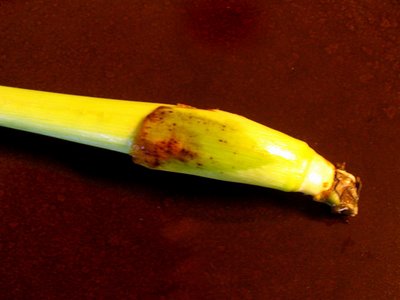Propagating Lemon Grass

Today we purchased a stalk of Lemon Grass (Cymbopogon ciatrus) at Filipino Food Store in Abilene for fifty cents. The owner of the store found a stalk of Lemon Grass for us that had started to grow a few roots. He suggested that we keep it in a glass of water until the roots have grown to a couple of inches long before we plant it outside.
Lemon Grass is a tall tropical grass. The fresh stalks and leaves have a clean lemon like odor because they contain an essential oil, which is also present in lemon peel.
Spice Description
Lemon grass is a long thick grass with leaves at the top and a solid portion several inches long at the root end. The lower portion is sliced or pounded and used in cooking. As a spice, fresh lemon grass is preferred for its vibrant flavor, but is also sold in dried form. The dried spice is available in several forms: chopped in slices, cut and sifted, powdered, or as an oil can be extracted from the plant.
Preparation and Storage
If using fresh lemon grass, use only the lower bulbous portion of the stem. It can be pounded and used whole or cut in slices. When using the ground powder (sereh) use one teaspoon as an equal to one stalk of fresh. It is advisable to soak dried sliced lemon grass for two hours before using.
When wrapped in a paper bag, lemon grass stems can last 2 to 3 weeks in the refrigerator. The stems can also be frozen for several months. Always wrap and store separately, as lemon grass will impart its flavor to other foods.
Culinary Uses
Lemon grass features in Indonesian, Malaysian, Sri Lankan and Indian cooking and is widely used in savory dishes and meat, poultry, seafood and vegetable curries. It harmonizes well with coconut milk, especially with chicken or seafood, and there are countless Thai and Sri Lankan recipes exploiting this combination. The stems are also used in teas or used in pickles and in flavoring marinades.
Attributed Medicinal Properties
The grass is considered a diuretic, tonic and stimulant. It promotes good digestion, and a preparation of lemon grass with pepper has been used for relief of menstrual troubles and nausea. It induces perspiration, to cool the body and reduce a fever. It is well known a mild insect repellent (citronella) and the essential oil is used in perfumery.
Plant Description and Cultivation
Lemon grass is a perennial tufted grass with long, sharp-edged blades. It grows in dense clumps in tropical or subtropical climates. Propagation is by dividing the root clump. The plants last three to four years and are harvested every three to five months. It is grown throughout Southeast Asia, Southern India, Sri Lanka, Central Africa, Brazil, Guatemala, the US and the West Indies.
Lemon Grass is a tall tropical grass. The fresh stalks and leaves have a clean lemon like odor because they contain an essential oil, which is also present in lemon peel.
Spice Description
Lemon grass is a long thick grass with leaves at the top and a solid portion several inches long at the root end. The lower portion is sliced or pounded and used in cooking. As a spice, fresh lemon grass is preferred for its vibrant flavor, but is also sold in dried form. The dried spice is available in several forms: chopped in slices, cut and sifted, powdered, or as an oil can be extracted from the plant.
Preparation and Storage
If using fresh lemon grass, use only the lower bulbous portion of the stem. It can be pounded and used whole or cut in slices. When using the ground powder (sereh) use one teaspoon as an equal to one stalk of fresh. It is advisable to soak dried sliced lemon grass for two hours before using.
When wrapped in a paper bag, lemon grass stems can last 2 to 3 weeks in the refrigerator. The stems can also be frozen for several months. Always wrap and store separately, as lemon grass will impart its flavor to other foods.
Culinary Uses
Lemon grass features in Indonesian, Malaysian, Sri Lankan and Indian cooking and is widely used in savory dishes and meat, poultry, seafood and vegetable curries. It harmonizes well with coconut milk, especially with chicken or seafood, and there are countless Thai and Sri Lankan recipes exploiting this combination. The stems are also used in teas or used in pickles and in flavoring marinades.
Attributed Medicinal Properties
The grass is considered a diuretic, tonic and stimulant. It promotes good digestion, and a preparation of lemon grass with pepper has been used for relief of menstrual troubles and nausea. It induces perspiration, to cool the body and reduce a fever. It is well known a mild insect repellent (citronella) and the essential oil is used in perfumery.
Plant Description and Cultivation
Lemon grass is a perennial tufted grass with long, sharp-edged blades. It grows in dense clumps in tropical or subtropical climates. Propagation is by dividing the root clump. The plants last three to four years and are harvested every three to five months. It is grown throughout Southeast Asia, Southern India, Sri Lanka, Central Africa, Brazil, Guatemala, the US and the West Indies.
0 Comments:
Post a Comment
<< Home